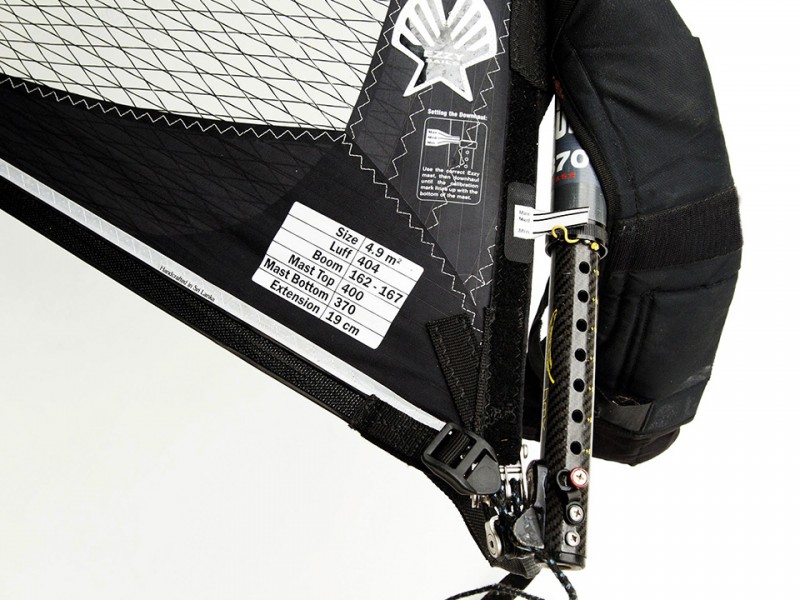LOW_DOWN - DAVID EZZY ON LOAD-CELL CALIBRATION

DAVID EZZY TALKS LOAD-CELL CALIBRATION

The Ezzy Sails boss is famous for his stringent quality controls in their Sri Lanka factory. So, with something as vital as downhaul settings, how do Ezzy so confidently set their tension indicators so accurately?
When you first see the downhaul indicators they instantly seem so obvious.
I came up with the idea for the calibrated rigging system while sitting on the beach a few years ago with [my son] Graham.
We were staring at a sail, trying to figure out how to record the correct downhaul. The problem was that this particular proto didn’t really go loose in the upper leech, so the traditional downhaul indicators on the leech did not work.
Graham had the idea to use a mark on the extension and this got me thinking about using a load cell. I wanted a system that was easy, repeatable and that would work with any mast extension.
It’s kind of like the difference between digital and analog. Digital is 100% repeatable and analog is not. Imagine if I gave 20 identical sails to 20 people, all around the world.
Of these 20 sails, 10 have no calibration system and 10 have the calibration system.
For the 10 people without the calibration system, I would tell the people to downhaul until the upper leech looseness extends to a certain point in from the leech.
Out of these 10 people, I would probably end up with about 10 different downhaul settings. This is because observing the upper leech looseness is very subjective.
Having the leech is elevated off the ground or lying on the ground will change the appearance of the looseness. Plus, the amount of outhaul can change the leech looseness.
It is simply difficult for most people to judge exactly where the looseness is actually extending to on the panel.
Now, for the other 10 with the calibration system, I would tell them to downhaul until the calibration mark lines up with the bottom of the mast.
Of these 10, all will rig to the exact same downhaul, just as if I had downhauled their sails for them.
Why haven’t we all done this before?
I ask myself that all the time. Most sail factories would have a hard time implementing it, because it takes rigging EVERY sail.
Most factories rig just a handful of sails, if any, per day.
How do you keep them accurate when there’s no fixed mast cap on some models?
You don’t need a fixed mast cap to make the calibrated system work. In the factory, we set the adjustable cap to its shortest position before pulling on the load cell.
As long as the customer leaves the head cap where we set it, then the calibration system works. Another nice thing about the calibrated downhaul is that it is customized for every sail.
Since it is works with force on the luff, not length, it allows for any slight cutting or sewing discrepancies in production that might change the luff length by a few millimeters.
It also doesn’t matter where you set your mast extension because it references the bottom of your mast.
How much do you balance data collection from load measurements like this and good old fashioned feel as each product evolves?
I first test the sail on the water without the load cell mark, then, when I find the right settings, I go back to the loft and stick the sail on the load cell to record the downhaul tension.
In essence, the load cell and calibration mark is guaranteeing that the sail will be rigged to the same downhaul as I found in my testing.
Do you have a massive database or are you a notebook and pictures kind of guy?
Yes, both. Over the past 30 years, I have acquired a massive database. I use notebooks as well as spreadsheets.
How does the downhaul calibration system work with non-Ezzy masts?
If the mast is exactly the same length and bend as our mast, it will work.
If not, the calibration system won’t work. On most sails we try to give an alternate rigging system for people that don’t own our masts.
Anything else we should know about rigging Ezzy sails or tips we can all use on all our sails to tune them better?
I cannot emphasize enough how important the proper tuning is to ANY sail. Imagine if every time you got to the beach you had to re-shape the rocker in your board, the volume, and the tuck in the rail?
Well, that’s what rigging a sail is analogous to. Without the mast and boom, the sail is just a lump of cloth. Sliding the mast in and downhauling starts bringing the lump to life.
Getting the perfect downhaul transforms it into a precise aerodynamic foil. Unfortunately, most people don’t know how much downhaul to put on their sail and consequently many sails go their lifetime being rigged incorrectly.
As a designer, it’s not just enough to design a nice sail, if my customers don’t love their sail, then I haven’t done my job. The calibrated downhaul system insures that my customers will get the exact performance out their sails as I intended.
Thanks David
The post LOW_DOWN – DAVID EZZY ON LOAD-CELL CALIBRATION appeared first on Windsurf Magazine.
